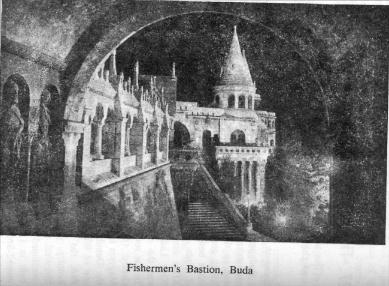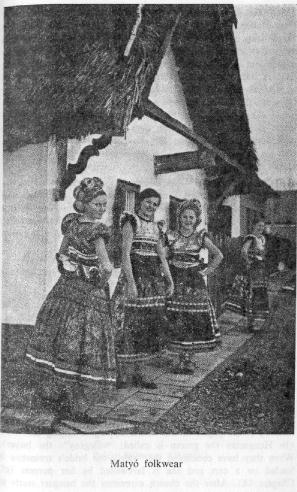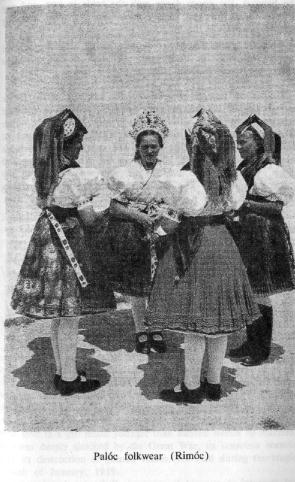| Timeless Nation |
27. THE HEART AND THE HEIGHTS
(The settlement, land, art, customs and way of life of the people of Budapest and Northern Hungary)
Budapest: the Heart of the Nation
Budapest (population 2 million) arose from the union of two towns, Buda and Pest, in 1873. Buda, the older town, situated on the western hills, has been Hungary’s capital since the XIVth century. It was under Turkish occupation for 145 years. Often besieged, damaged, destroyed and rebuilt the royal castle of Buda preserves the memories of many periods since the XIIth century. Near the royal palace, the seven-centuries-old ‘Our Lady" cathedral ("Coronation" or "Matthias" Church) was the scene of the crowning of several Hungarian kings. To the south lies the "Gellert" hill – named after Bishop Saint Gerard (Gellert), who helped Saint Stephen to convert the Magyars to Christianity in the XIth century. Seven bridges span the Danube between the two cities: all were destroyed at the end of World War II and rebuilt afterwards. On the east bank Pest, the administrative, business and cultural centre of the country, possesses innumerable buildings and monuments of historical or cultural significance, among which we have already mentioned a few in other chapters. The Academy of Sciences, built in 1862 in Italian neo-Renaissance style, and the monumental Szent Istvan (Saint Stephen) basilica (1851, neo- Renaissance) deserve particular mention. A remarkable monument, the "Millenium Monument", stands near the City Park: a tall, slender column topped by the figure of a flying angel; the base is surrounded by many statues representing the important historical figures of Hungary. The work was created by the sculptor Gy Zala on the occasion of Hungary’s millenary celebrations (1896). The replica of the historic castle of Vajdahunyad in the City Park was built on the same occasion. The nearby Museum of Applied Arts is an interesting example of Odon Lechner’s "Magyar-Secessionist" style (1893).

Margaret Island, now a national recreation area, was named after Saint Margaret of the Arpads (XIIIth century), who spent her life in prayer and work on this island.
Almost halt of Hungary’s industry is concentrated in and around Budapest, especially in some suburbs (Csepel, Ujpest, Kispest etc.). An interesting fact is that several suburbs and townships nearby (Szentendre) are inhabited by Slovak, Serb, German and other nationalities, which have preserved their ethnic culture and way of life for centuries in the heart of the country.
The loyal Norlh
Northern Hungary, or the "Uplands" ("Felvidek"), is the region of historic Hungary bounded by the northern Carpathians, the Danube and the Great Plain in the south. This area has suffered less from the vicissitudes of Hungarian history than the others. Since 1920, most of the area has belonged to the newly created state of Czechoslovakia. Since 1945 the eastern district (Ruthenia) has belonged to the Soviet Union.
The population of the Uplands consists of Slovaks, Magyars, Germans and Ruthenians (Carpatho-Ukrainians). The Slovaks, the largest group (2 million), are the only non-Magyar indigenous group in the Carpathian basin. During the thousand years as citizens of the Hungarian state, the Slovaks have kept their language, culture, way of life and national identity. Their numbers have increased considerably, partly because of the sheltered nature of the region, partly through immigration of neighbouring Slav elements. Though many Slovaks rose to the ranks of the Hungarian leading classes through services to the Church or State, the Slovaks of the mountain villages did not assimilate (no one told them to). There had been no antagonism between Magyars and Slovaks before the XXth century when external political agitation stirred up "independence" and "liberation" movements among them, with limited success. Before that time, the Slovaks had always been the Magyars’ loyal comrades-in-arms in their common struggle against oppression, especially in Rakoczi’s time. The Magyars have always found the mild-mannered, art-loving, industrious Slovaks close to their hearts. Thus it frequently happened that in villages with mixed Magyar and Slovak populations the Magyars integrated into the Slovak community. The opposite happened less frequently; in fact, large isolated Slovak settlements have maintained their ethnic identity in the south of the Great Hungarian Plain.
The Ruthenians or Carpatho-Ukrainians (about 500,000), who migrated to the eastern districts of the Uplands during the Middle Ages, have been peaceful, honest and loyal subjects of the Hungarian state. They, too, wholeheartedly supported the Hungarians in their freedom struggles and earned the epithet given to them by Rakoczi: "gens fidelissima" ("the most faithful people"). The Germans, called Saxons, settled during the XIIIth-XIVth centuries in the central northern towns and have similarly been loyal citizens of the country of their adoption. During the struggles against Austrian-German oppression these German-speaking Hungarians stood faithfully by their Magyar brothers.
The Magyar population is concentrated in the southern counties of the region, but there are pockets of rural settlements everywhere, while the urban population was largely Magyar before 1920. Certain Magyar groups show marked ethnic cultural characteristics, such as the Paloc, the Magyars called "Matyos" etc. Due mainly to the isolation caused by the mountains, the people of these districts have developed different customs and folk-art, in spite of their common Magyar origin.

Some towns of historic and cultural interest
Kassa (today Kosice, Czechoslovakia) is the largest city of the northern central area, with memories of various freedom struggles. Its cathedral, named after Saint Elizabeth of Hungary and built in 1360, is the finest remaining example of Hungarian Gothic architecture. The remains of Ferenc Rakoczi and his mother, Ilona Zrinyi, rest in the crypts of the cathedral. The interior of the church contains many outstanding examples of XIVth-XVth century Hungarian wood-carving, painting and decorative art.
Pozsony (today Bratislava, Czechoslovakia), near the western border, used to be the administrative capital of Hungary in Turkish times. Several Habsburg kings were crowned here and it was the seat of what passed for a Hungarian "Parliament" during the XVIth-XVIIIth centuries (until 1848).
Nearby is Trencsen, the centre of "Matyofold" a region named after Mate’ ("Matyus") Csak, a rich feudal lord who was Palatin of Hungary in the XIVth century. Csak, a descendant of a Magyar tribal chieftain of the IXth century and Hungarian chief minister, would have been amused to learn that certain imaginative historians have identified his name with the word "Czech" and claimed Czech supremacy over "Matyusfold" during Csak’s feudal tenure. (This was one of the "proofs" submitted to the Trianon Peace Treaty Commission . .)

The northern "Saxon" towns (Locse, Kesmark, Eperjes present an interesting synthesis of Hungarian history and local German tradition.
The southern hilly fringe of the region belongs to Hungary The largest city here is Miskolc, second largest city in Hungary. Near the industrial complex of Diosgyor lies the historic castle built by the Anjou kings (XIVth century). Near the Tokaj vineyards lies Rakoczi’s castle of Sarospatak, famous also for its old Protestant College. Eger is rich in historic relics, such the fort which Istvan Dobo defended successfully in 1552. The archiepiscopal see has many Baroque and Renaissance church~ Visegrad is situated at the bend of the Danube. Its gothic palace built in the XIIIth and XIVth centuries was the favourite residence of the Anjon kings and Matthias.
Magyar folk alt and crafts in the Uplands
The Magyars of this forested area use wood to a great extent to make carved furniture, wooden vessels, musical instruments and buildings. Timber belltowers, carved wooden steeples and ornamental carvings abound in Catholic villages of the area.
The most characteristic aspect of the Magyar folk art in the area is the colourful folkwear, which shows many different styles. In the districts closer to the Plain, brighter colour scheme shorter skirts and lighter footwear types are found. The Paloc of Boldrog are particularly famous for their elaborate head-dresses ("parta") worn by the young brides. Bujak is know for the vivid colours of the skirts worn over many petticoats
The rich peasants of Martos (now Czechoslovakia) wear golden and silver lace-decorated coifs and many silver chains.
The Matyo folkwear is world famous. These descendants of King Matthias’ Magyar bodyguard live in a few villages around Mezokovesd in Borsod county. Their characteristic folk art was inspired by the Gothic-Renaissance styles of Matthias’ court. The magnificent costumes of the women, with lines of almost gothic delicacy, are richly embroidered. Though they use vivid colours as well, the aristocratic combination of white on black is the favourite. The women present a tall slender figure in their ankle length skirts, which flare out slightly at the bottom The narrow apron is made of black or dark blue material with white embroidery. Men’s articles are also multi-coloured: their long wide sleeves and shirt collars are embroidered, as are the aprons.
Embroidery is used – in addition to costume decoration -in ornamenting bedcovers, scarves and pillow-slips. Home-weaving is used for decorative material and recently there has been marked revival in home-weaving and embroidery in the Paloc districts where it is becoming part of a thriving rural industry.
Some folk customs of the Uplands
The marriage customs illustrate well the Paloc’ strict moral code and colourful traditions.
When a boy has found a girl acceptable to his parents, he asks the girl’s mother for the hand of the girl. If he is acceptable the girl gives him a token present (in Matyo villages: an apron The boy announces his engagement by wearing a rosemary to church and the girl’s gift, but does not disclose her name. They rarely meet in public. After a courtship of two to three months (carefully chaperoned) the wedding takes place usual in a day-long celebration The groom sends his best man fetch the bride. At the bride’s home, the envoy performs the ceremony of "buying" the girl. This pantomime revives the memory of the pagan custom of kidnapping or buying the bride (In Hungarian the groom is called: volegeny: the buyer) When they have concluded the "sale", the bride’s trousseau is loaded on a cart and she is farewelled by her parents (cf, Chapter 18). After the church ceremony the banquet starts at the groom’s house.
The bride and bridegroom often eat in a different room accompanied by the bridesmaids. During the dance, following the banquet, the guests dance with the bride in turn and pay a token price for each dance (there are no other wedding presents given).
When the guests disperse, the young couple sleep in different rooms. Not until the bride opens the door of her own will is the young husband allowed to join her.
The tedious task of corn-husking, the stripping of the lea and shelling of the ears of corn (maize), provides a pleasant opportunity for social gatherings in Upland villages on winter evenings. Relatives and friends gather (with their children) at the farmer’s house to help him. The entertainment includes tales told by old people, songs from the girls and boys and games. When someone finds an ear with red corn on it, finder is entitled to kiss the person next to him (strangely enough, it is always a boy who finds the red corn and there is always a girl sitting next to him).
* * *
As a child l spent many magic winter evenings in these car husking gatherings, listening to ballads, songs, fairy tales and legends, sharing the warmth of belonging and love with those gay, simple artists of life. As the village of my birth had mixed Magyar-Slovak population, the gatherings and games we often mixed, too. In fact at a very early period of my life thought that the (rather delightfully) "different" children (i.e. girls) were Slovaks. Somehow I have liked "Slovaks" ever since . .
I sincerely wish that no greater misunderstanding should ever come between Magyars and Slovaks. .
| Timeless Nation |